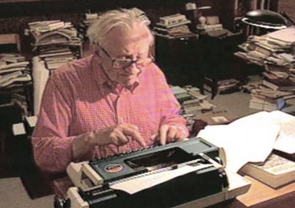Sometimes you don’t really get to know someone until after they die. Sometimes a person’s death can be like the nova of a star, an explosion that broadcasts the star’s existence to places that had never seen it before, right before the star’s light goes out forever. It’s kind of sad when you don’t find out about someone until their death, but it’s also a kind of beautiful and special connection.
Such is the case with my connection to Studs Terkel, a radio broadcaster and oral historian who died in 2008. It was this wonderful hour-long radio program about his work that put him on my radar. Produced after his death by Transom.org, it brings listeners into the inner circle of Studs’ working community, so that you can feel like you’ve gotten to know him. “Working with Studs” feels kind of like a eulogy, and I feel privileged to get this glimpse into Studs’ life. One of the biggest ways it accomplishes its particular style of intimacy is by taking its time: it doesn’t rush the sensitive information, because that level of intimacy backfires if it comes too early in a piece.
There’s an image, early in the program, of Studs walking out of the elevator, talking as he walked. He does it as if to announce his presence on the floor… but also as a way to think, and to process his own ideas. This is a brilliant way to introduce Studs, as a character. He was an extrovert’s extrovert: he never stopped thinking out loud, and he cared deeply about other people’s reactions to his work.
So this story establishes Studs’ character by beginning with the most noticeable aspect of his personality: his talking. Then, midway through the piece, one voice starts adding a little nuance, asking, “If he was always talking so much, how did he get people to open up to him as well as he did?” Then another producer describes Studs’ tactic for getting intimate with interviewees: he shared a little of his own life in order to gain access to a particular aspect of theirs.
It’s after this that we approach the bigger paradox about Studs’ character: he wasn’t the greatest listener, and wasn’t very comfortable in his own skin. Even though he knew how to evoke emotions in other people’s stories, he didn’t really know about his own feelings.
Notice that this level of nuance doesn’t come until the last section of the piece, after you’ve gotten to know Studs’ more relatable and appreciable aspects. If the piece had introduced Studs as “a man who was uncomfortable in his own skin, who was also good at putting other people at ease,” it would be almost disorienting. You need to ease into that sort of complicated idea.
So don’t always jump straight to the most interesting stuff. Your characters can develop in a way that’s just like getting to know a person in real life. Start with the apparent, the things you notice first, and after that you can work your way toward the more paradoxical, intimate material.
Podcast: Working with Studs
Producted by: Sydney Lewis for Transom.org in 2010
Duration: 54 minutes
Article written by: Will Rogers on 6/20/2013
{jcomments on}

